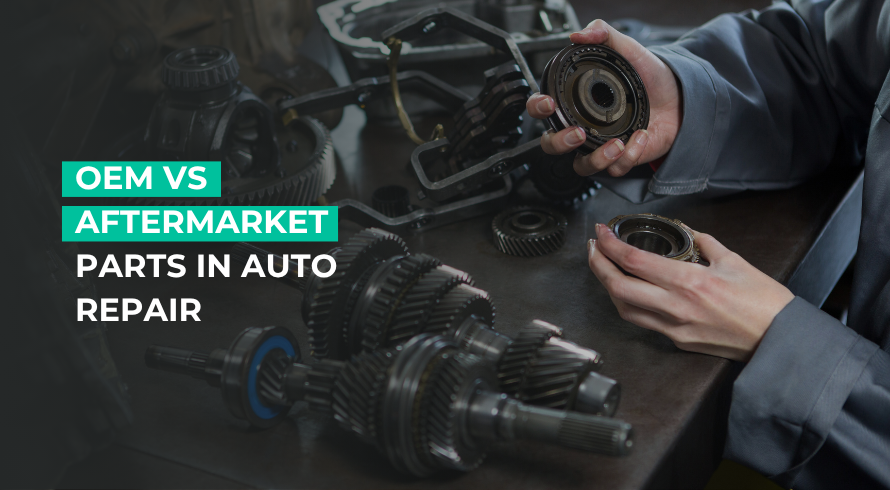Have you ever found yourself at the crossroads of car repair, scratching your head over whether to choose OEM or aftermarket parts? You’re not alone. This common dilemma can feel like deciding between a gourmet meal and a homemade dish—both have their merits, but which one truly satisfies your needs?
Understanding OEM and aftermarket parts
Let’s break it down:
- OEM (Original Equipment Manufacturer) Parts: These are made by the vehicle’s original manufacturer. Think of them as the exact replicas of the parts your car was born with.
- Aftermarket Parts: Produced by third-party companies, these parts are designed to fit and function like the original but aren’t made by your car’s manufacturer.
Pros and cons of OEM parts
Pros:
- Guaranteed fit and functionality
- Since OEM parts are made by the same company that built your car, they fit perfectly and work exactly as intended. You won’t have to worry about compatibility issues or modifications.
- Consistent quality and performance
- These parts meet the exact specifications of the original, ensuring your car runs as smoothly as when it first rolled off the lot.
- Easier selection process
- There’s no guesswork when buying OEM parts—you know you’re getting the right part without comparing multiple brands.
- Retains vehicle value
- If you plan to resell your car, buyers might prefer a vehicle with original parts rather than aftermarket replacements.
- Warranty coverage
- Most OEM parts come with a manufacturer-backed warranty (typically 1 year or more), providing peace of mind if something goes wrong.
Cons:
- Higher cost
- OEM parts often cost 20-60% more than their aftermarket counterparts, which can make repairs expensive.
- Limited availability
- Since OEM parts are mainly sold through dealerships, they might not be readily available at independent repair shops. If they are out of stock, you may need to wait for a special order.
- Potentially outdated designs
- Some OEM parts don’t evolve as fast as aftermarket options, meaning newer technology or improved materials may not be available.
- Lack of variety
- You only have one option—the manufacturer’s version of the part. If a more efficient or cost-effective alternative exists, you won’t find it under the OEM label.
- Higher installation costs
- Since dealerships and authorized repair centers often handle OEM part installations, labor costs might be higher compared to independent mechanics who work with aftermarket parts.
Pros and cons of aftermarket parts
Pros:
- More affordable
- Aftermarket parts typically cost 20-50% less than OEM parts, making them a budget-friendly option.
- Wider availability
- Unlike OEM parts that are limited to dealerships, aftermarket parts can be found at auto shops, online retailers, and even local mechanics. This makes them easier and faster to purchase.
- Variety of choices
- Many third-party manufacturers produce aftermarket parts, offering different materials, performance levels, and price points to suit various needs.
- Potential for better performance
- Some aftermarket brands improve upon OEM designs, using stronger materials, better technology, or enhanced durability. Performance-focused parts like brake pads, air filters, and suspension components often exceed OEM quality.
- Faster innovation
- Since aftermarket manufacturers don’t have to stick to the exact specifications of car manufacturers, they can improve parts over time, integrating newer materials and designs.
- Can help lower insurance costs
- Some insurance companies may recommend aftermarket parts because they are cheaper, reducing repair costs and, in some cases, lowering premiums.
Cons:
- Quality varies
- While some aftermarket parts exceed OEM quality, others are made with lower-quality materials that wear out faster. It’s important to research brands before making a purchase.
- May not fit perfectly
- Since aftermarket parts are designed to fit multiple makes and models, they may not always fit as precisely as OEM parts. This can lead to installation challenges and additional labor costs.
- No standardized testing
- OEM parts go through rigorous testing and quality control, while aftermarket parts may not always meet the same standards. Some cheap aftermarket parts might not last as long or perform as well.
- Warranty concerns
- Some aftermarket parts don’t come with a warranty, or if they do, it may be much shorter than an OEM warranty. In some cases, using an aftermarket part could void your car’s existing warranty.
- Overwhelming choices
- With so many brands and options available, choosing the right part can be confusing. Without guidance, you may end up with a lower-quality part that doesn’t perform as expected.
When should OEM parts be used?
OEM parts aren’t always necessary, but in certain situations, they are the best and safest option. Here’s when you should consider choosing OEM over aftermarket:
1. For critical safety components
If the part directly affects your safety, it’s best to stick with OEM. Why? OEM parts are built specifically for your vehicle and undergo rigorous safety testing before hitting the market. Aftermarket alternatives might fit, but there’s no guarantee they’ll meet the same engineering and crash safety standards.
Examples of safety-critical components where OEM is recommended:
- Brakes – An improperly fitting brake pad or rotor can reduce stopping power and increase wear.
- Airbags – A faulty or ill-fitting airbag could fail to deploy correctly in a crash.
- Suspension parts – Shock absorbers and struts directly impact how your vehicle handles, especially in emergencies.
- Steering components – A poorly designed aftermarket tie rod or ball joint could lead to steering failure over time.
2. If you want to maintain vehicle value
If you ever plan to sell or trade in your car, having OEM parts can increase its resale value. Buyers (and dealerships) trust factory-original components because they ensure the vehicle remains in original condition.
Why OEM parts matter for resale:
- Cars with OEM parts maintain their original specifications, which used car buyers prefer.
- Dealerships and car appraisers value factory-spec vehicles higher because they require less reconditioning before resale.
- Some warranties or certified pre-owned (CPO) programs only accept OEM parts, so using aftermarket parts could disqualify you from these benefits.
3. When your car is under warranty
If your car is still covered by the manufacturer’s warranty, using non-OEM parts could void it. Many warranties require OEM parts for repairs, especially for major components like the engine, transmission, and electrical system.
Check your warranty before choosing aftermarket parts, especially for:
- Engine components – Sensors, gaskets, and belts should be OEM to avoid complications.
- Electrical system – Alternators, ECUs, and wiring harnesses must match manufacturer specs.
- Hybrid & EV batteries – OEM batteries ensure compatibility with the vehicle’s software.
4. When you want a hassle-free repair
One big advantage of OEM parts? No guesswork. Since they’re made specifically for your car, they fit perfectly—no need for adjustments, trial-and-error, or modifications.
What can happen with aftermarket parts?
- A slightly off-sized body panel might not align properly, leading to gaps.
- An engine sensor that’s not calibrated exactly can cause the Check Engine Light to stay on.
- An improperly fitting headlight assembly could cause condensation or misalignment.
Closing thoughts
The OEM vs. aftermarket debate boils down to individual needs and circumstances. By understanding the differences and considering your specific situation, you can make an informed decision that keeps your vehicle running smoothly without breaking the bank.
Remember, whether you choose OEM or aftermarket, the key is to ensure the parts are high-quality and suitable for your vehicle’s needs.
FAQs
Is OEM or aftermarket better?
It depends on your priorities. If you value exact fit and original performance, OEM is the way to go. If you’re looking for cost savings and a variety of options, aftermarket parts might suit you better.
Do OEM parts last longer than aftermarket?
Generally, OEM parts are designed to match the original’s lifespan. However, some high-quality aftermarket parts can equal or even surpass OEM longevity.
Is it OK to use aftermarket parts?
Yes, especially for non-critical components. Ensure you research and choose reputable aftermarket brands to avoid quality issues.
What are the disadvantages of OEM parts?
The main drawbacks are higher costs and potential delays due to limited availability.
Accordion Title
Accordion Content









